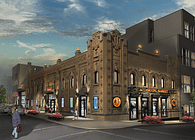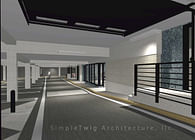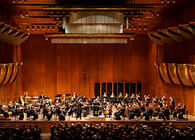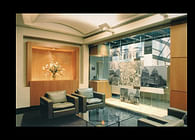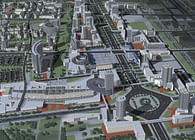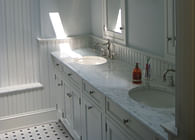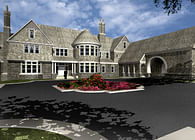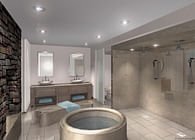
Brooklyn, NY
Bamiyan Cultural Centre
This proposal is about these people and their culture…
One human standing on this earth can change the world.
Together, we can change everything for the better of all.
First, we acknowledge the place which allowed the culture of these people to develop, a valley of green with it's built structures pushed to the sides and onto the slopes to preserve this fertile green oasis which has it's sustaining power. Thus our proposal positions it's buildings on the slopes of the site as it exists and therefore not only shows respect but acts as a reminder of the lessons of the past, to preserve the fertile flatland, both for it's usefulness but also to preserve it's beauty. It is the striking contrast of the valley and surrounding hills and mountains that makes this region truly a special place on earth and as such our composition seeks to do the same.
Further, we acknowledge the Architectural history by creating a complex that both echoes the practical aesthetic of the local vernacular employing similar construction methods (mass walls, parapets and water collection and punched openings) but raises it to a level appropriate for a cultural center for this specific area, so the people of this region can embrace it as their own and share a seance of pride as their accomplishment.
Second, we acknowledge this region as a trading route, embracing people from other cultures, thus our proposal reaches out with 'fingers' to welcome people's of all backgrounds.These lines in the proposed landscape are the fingers of hands reaching out to people of all backgrounds in a welcoming gesture, to bring people together for the common good and with an eye towards an appreciation of all of humanity, one connection at a time. Third, we acknowledge the people of this region, who have toiled for centuries to make their world and their life, thus our proposal surrounds the core of our composition with wire figure statues, of people coming together in a circle to make this project happen, to reflect on the past, to embrace the future. Further, over-scaled bas-reliefs etchings of local residents, especially young individuals, will adorn the exterior wall of the auditorium, to remind people that this place was built by locals for the future of their people. This acknowledgment of the people is a reflection of 'people coming together to make this great project a reality.
Circular Exterior Atrium:
This special outdoor space which surrounds the auditorium with it's wire sculptures and hanging banners, provides access to all public spaces, including the cafe at the lowest level, both exhibition spaces and the library. There is also mechanical room and other utility spaces centrally situated under the main entrance. After a performance or lecture, the auditorium stage doors can open allowing guests to cross the stage and sit on steps overlooking the Bamiyan valley. This area will be a great place for seating, tables and casual conversation. Beyond the cafe is access to the great lawn.
Views to Cliffs:
The cafe and Library are positioned to allow guests to enjoy the views. In addition the entire academic and administrative wing affords views of the entire valley over the great lawn. Finally the Auditorium has full height doors which can be opened to give the audience a view of the cliffs, the room itself rotated to allow views of both major niches. Only the storage and exhibition spaces do not have direct views, as one's attention would be directed at the artifacts on display.
Main Public Hall
If one were standing at the cafe, they could ascend along the perimeter of this atrium up to the library passing under the Bamiyan Stair Bridge , remaining outdoors. The ‘Bamiyan Stair Bridge’ is our notion of a physical connection between guests who visit this complex to view a performance, and those who have studied and practiced to perfect their skills in realizing a cultural event and then present that event to the public. The bridge connects these two groups. Descending the bridge one can see into the Performance Hall and, if the stage doors are open, onto the valley below.
The entrance to the building, situated on the highest level of the complex and thus provides security with a commanding centralized location, leads directly to the Bamiyan Stair Bridge and into the Auditorium, or splits on it’s flanks to two smaller stairs that lead into the courtyard atrium space. Alternatively, from the entrance, one can move to the left balcony overlooking one of the exhibition spaces and then proceed down a series of ramps into this space. From this exhibition space, one can either enter directly into the library or at the other end move into the other exhibition space providing the option that an individual can stay indoors for the main public components., leaving the Tea House and Retail Space being the only venues that must be accessed from the exterior of this main building complex, so they can control their opening hours.
The notion "This proposal is about these people and their culture…" means, it is not appropriate to build an edifice that reflects some western sensibility, but instead to solidly and with pride reaffirm the culture of the Bamiyan people, for this is a cultural center of their culture and not a center for another culture. I only hope (at the time this post was written the results of the competition are not known) that the jury understands the ramifications of this statement and embraces this notion for whatever project they choose to represent the Bamiyan Afghan culture. ~NBuccalo
Image(s) and text, copyright 2015 © SimpleTwig™ all rights reserved.
Status: Competition Entry
Location: Bamiyan, AF
Firm Role: Team Leader
Additional Credits: Basia Mielczarek
